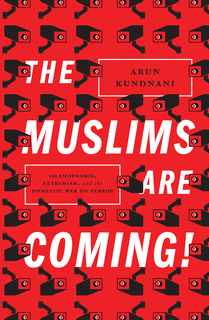If Islam creates terrorists, how come the terrorists aren’t all that “Islamic”?
Posted: September 28, 2014 Filed under: Islamophobia | Tags: Arun Kundnani, Pamela Geller, radicalization thesis Leave a comment[Continuing the theme of the last post.]
The following is not about Hamas specifically, but this quote is prescient:
That religious arguments are used by Hamas to legitimize its ceasefires as much as they are used to legitimize its violence suggests that religious ideology does not provide an adequate explanation of its behavior. -Arun Kundnani
* * *
Turns out two British men convicted for “terrorism-related offences” prepared for their Syrian ‘jihad’ by purchasing “Islam for Dummies” and “Koran for Dummies.” Any decision to take Islam seriously came after the decision to hurt people; it couldn’t have been the cause. At best, religion provided a language in which to express their anger over world events and discrimination at home.
The evidence suggests the British “dummies” are the norm. In his book, The Muslims are Coming!, Arun Kundnani examines every high-profile ‘Islamic’ terrorist attack on US and British soil in recent memory. Behind each he uncovers a narrative similar to the above. It appears the average “Islamic terrorist” is a religious outlier-turned-wannabe with fundamentally political gripes.
To my knowledge (which is of course expansive), every serious study of the issue reinforces this conclusion. For a sampling:
(1) MI5, the British intelligence agency, performed exhaustive case-studies on “several hundred individuals known to be involved in, or closely associated with, violent extremist activity” (2008). It found that most “Islamic” recruits are “religious novices” from relatively unobservant households; nor are they operating under the guidance of any or radical extremist cleric. Many “are involved in drug-taking, drinking alcohol and visiting prostitutes” (so much for hating our freedoms). The report found “evidence that a well-established religious identity actually protects against violent radicalization.”
(2) A 2010 report by the UK think tank Demos profiled more than 200 Islamists throughout Europe. Some were convicted terrorists, while others held radical beliefs but hadn’t turned to violence. The study found systematic differences between the two groups: The actual terrorists “had a simpler, shallower conception of Islam than radicals—that is, their degree of interest in the actual teachings of the Koran was fairly minimal.”
(3) A 2008 Gallup poll of Muslim attitudes worldwide found no correlation between religious devotion and favorable views toward “jihad”-style violence. The 7% of Muslims classified as “radical”—defined in part by their sympathy for the 9/11 attacks and hostility toward the US—were found to be no more religious than the rest of the population surveyed. The same year, Pew Research replicated the basic results, finding that Muslims who believe “attacks on civilians can be morally justified” are no more observant than those who oppose such attacks.
And so on. (Seriously, I could go on and on here.)
All of this undercuts the view of Pam Geller-style Islamophobes, who see terrorist violence as issuing forth more or less automatically from Islamic holy texts and the “ideas” contained therein. In this view, those “moderate Muslims” who don’t engage in violence against us kafirs are simply not reading their Quran closely enough.
This opinion is more than wrong; it is dangerous.
Kundnani concludes his book with a story about “Boston Bomber” Tamerlan Tsarnaev. (Like the “dummies,” the Tsarnaev brothers weren’t particularly religious before considering a turn to violence. In his famous “boat scribble,” and later to the police, the surviving brother Dzokhar attributed their motivation to US foreign policy.)
Three months before the attack, Tamerlan, angry about US military action in Afghanistan and Iraq, interrupted the imam of his mosque in the middle of Friday prayer service. The topic was a celebration of Martin Luther King, Jr., who Tamerlan accused of being a sell-out for limiting himself to non-violent tactics. The imam silenced the outburst by kicking Tamerlan out.
Kundnani writes:
Since 9/11, mosque leaders have been under pressure to eject anyone expressing radical views rather than to engage with them and seek to challenge their religious interpretations, address their political frustrations, or meet their emotional needs. That policy has been forced on mosques by the wider climate of excessive surveillance. It has made mosque leaders wary of even having conversations with those perceived to be radicals for fear of attracting official attention. They fear that every mosque has a government informant listening for radical talk.
Continuing:
The Tsarnaev brothers were said to be angry about US foreign policy in Afghanistan or Iraq…[b]ut because discussions of foreign policy have been off-limits in mosques since 9/11, they were unlikely to have had their anger acknowledged, engaged, challenged, or channeled into nonviolent political activism.
The issue goes beyond mosques. The Islamophobic obsession with “radical ideas” has led Muslim community leaders to eschew engagement with these ideas on any level. Salma Yaqoob, former Birmingham (UK) councilor, traces this policy to its ultimate conclusion. As quoted by Kundnani:
If Muslims organizations are reluctant to provide the space for sensitive discussions for fear of extremist’s accusations, where are these young people to go? Where will their views and concerns get an airing? The answer is obvious. They will be expressed in private and secret, with the genuine extremists keen to provide listening ears and simplistic solutions.


